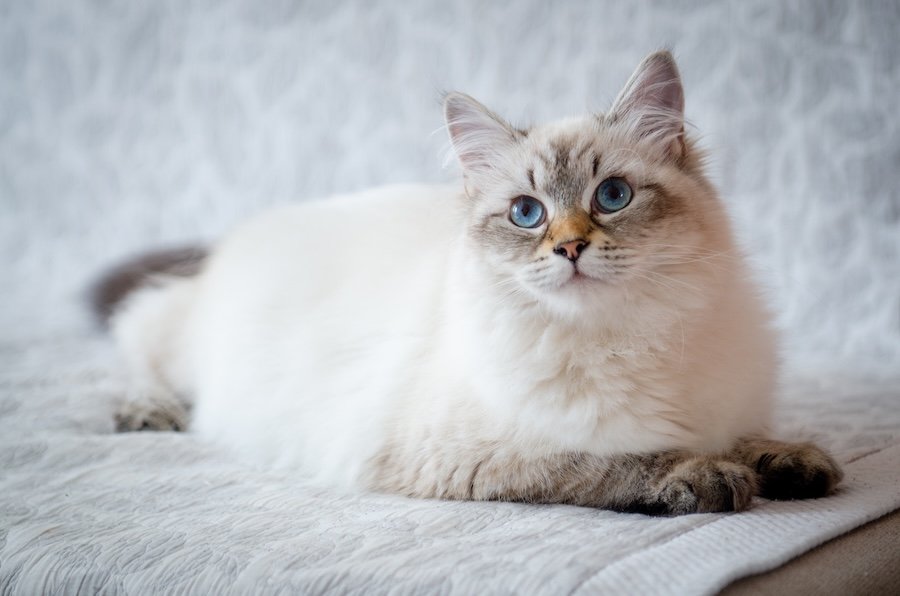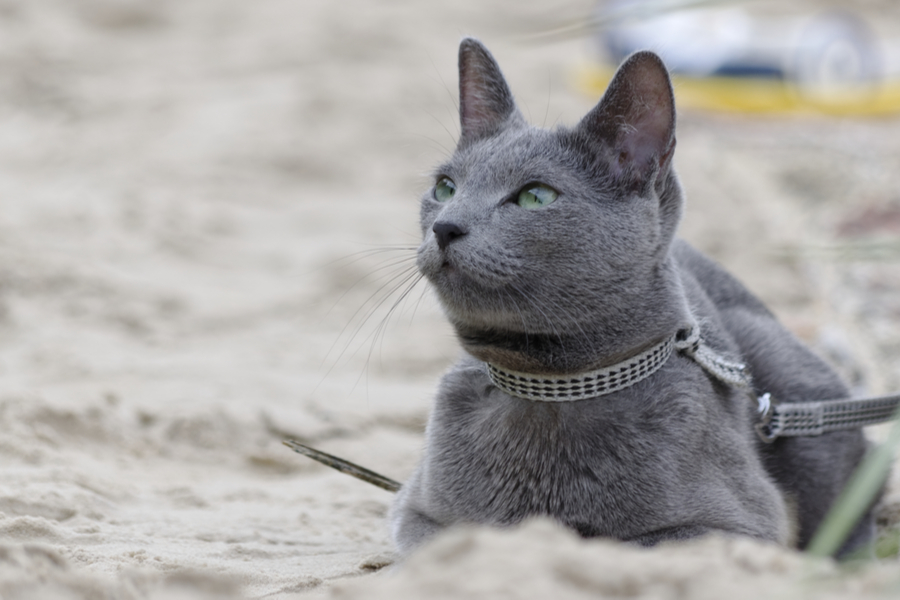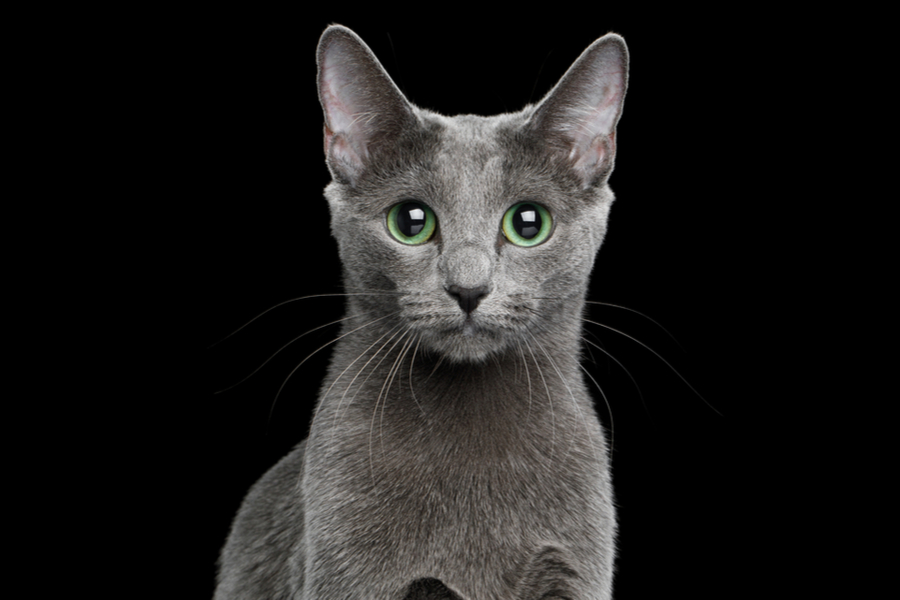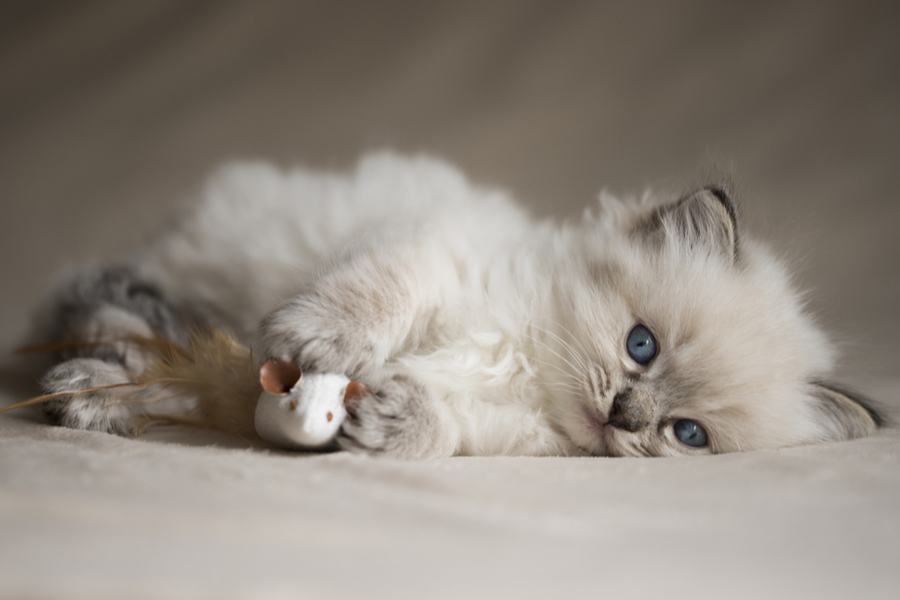Average sizes and life expectancy for this breed:
The Neva Masquerade cat breed is as exotic and appealing as it sounds! Hailing from Russia, these beautiful, playful felines are the sister breed to the loveable Siberian Cat. The main difference between these two stunning long-haired breeds is their colouring. Neva Masquerades are a colourpoint variant of the Siberian with piercing deep blue eyes.
The name ‘Neva Masquerade’ refers to the Neva River in St. Petersburg where the breed was first developed around the late 1970s. If you are looking for an affectionate, lively companion that’s guaranteed to draw attention wherever it goes, the Neva Masquerade could be the perfect kitty for you.
Unlike many other cat breeds, Neva Masquerades are highly social, making them great additions to any family home. In fact, in their native Russia, they are renowned for being particularly good with children because of their playful natures and chilled demeanours. They also mature later than other breeds, making them the perfect playmates for children young and old!
The Neva Masquerade was first recognised as an official breed by FIFe (Fédération Internationale Féline) in 2011. However, it’s still commonly referred to as a Siberian because, aside from colour, the two breeds share many of the same traits.
If you yearn for a warm, cuddly companion who’s independent yet extremely loving, the Neva Masquerade could be perfect for you. These cats will happily dash after a toy, follow you from room to room making adorable chirping noises, or curl up on your lap at the end of a long day. They just need owners who can cater to their social needs and be able to brush their long, thick fur several times a week.
See available kittens




The Neva Masquerade was first developed in the late 1970s/early 1980s in a region of St Petersburg near the Neva River. This was also around the same time that Siberian cats started to be systematically bred as pets. Long-haired cats were rare in Europe before the 19th Century, so you can imagine the stir these beautiful long-haired cats created! They particularly caught the attention of merchants and travellers.
However, perhaps surprisingly, Siberian cats are believed to be descended from wild cats, with a much longer history than their domestic heritage suggests. In fact, references of Siberian-like cats date as far back as 1000 AD, particularly in Russia and Siberia.
Famine and droughts were common in the first half of the 20th century in this area, which meant that Siberian cats had to fend for themselves. This created a highly intelligent, independent breed with a thick waterproof coat that has been loved the world over since the early 1990s.
Originally known as the Siberian Forest Cat, they became officially recognised as Siberian cats in 1991 to distinguish them from the Norwegian Forest Cat breed.
It’s thought that the Neva Masquerade breed was created by breeding Siberian cats with Asian colourpoint cats such as Siamese or Thai cats. They started to show up in multiple different countries by 2010 and they are getting more popular day by day. Some cat registration organisations class them as a separate breed to the Siberian, however, they are still commonly seen as traditional Siberian cats. Certain associations such as FIFe and the Cat Fanciers Association will only allow the breeding of Neva Masquerades with other Neva Masquerades to protect the breed from unwanted mutations. This small gene pool can cause them to be more susceptible to developing hereditary diseases. However, dedicated breeders have now developed a gene test to also identify the colourpoint gene in standard Siberian cats.


The Neva Masquerade is a striking medium to large long-haired breed with a triple-layered waterproof coat that’s designed to keep them warm in cold, harsh weather conditions. Their overall appearance is a muscular one that portrays strength, stamina, intelligence, and balance. These cats have very muscular thighs, large, compact paws with prominent tufts, and a bushy tail that tapers slightly towards the tip. The coat itself is accentuated with a thick ruff of fur around the neck, as well as fluffy britches.
Their heads are broad with low set cheekbones and a rounded muzzle. Their ears sit upright and slightly rounded at the tips. All forest cat breeds, like the Siberian and the Norwegian Forest, generally have tufts of fur on their ears which makes them look more pointed than they actually are. These cats also have hair inside the ears to protect them from the elements.
One of the most distinguishing features of the Neva Masquerade breed is their deep blue eyes. The eyes themselves are large, slightly oval, and set wide apart on the head.
These cats have a very thick, soft undercoat that needs to be groomed regularly to prevent matting. The topcoat is shorter, coarser, and more water repellent. The coat is longer around the neck, chest, hind legs, and tail. However, coat length and thickness are known to change with the seasons, being shorter and lighter in the summer months.
Neva Masquerade cats have a colourpoint pattern on their coats, which simply means that the coat is darker on certain body parts, usually the face, tail, ears, and paws. Interestingly, this coat pattern is thought to be caused by a gene that makes the coolest parts of the cat's body visually much darker than the rest. Neva Masquerade kittens often lack the colourpoint markings. Instead, they develop slowly as the cat grows. That said, studies have shown that the prominence of colourpoint markings on these cats depends on external temperature. Kittens brought up completely in a very warm environment rarely develop these markings at all. So, variety is key for a Neva Masquerade to develop its true beauty!
These cats come in a wide range of colour combinations, with new ones appearing all the time. Some of the more common varieties include:
Just like other Siberian cats, Neva Masquerades are very playful, right into adulthood. It can take up to five years for these cats to fully mature, which means they remain kitten like for a long time. This makes them great companions for families with children of all ages. One of the most unusual traits of these cats is that they love to play in water! So, if they are introduced from a young age, water play can be a great bonding experience. They seem to especially love trying to paw toys out of a water bowl.
These cats are highly affectionate but without being overly clingy. They thrive on receiving regular attention from their owners and will happily follow you from room to room! However, unlike other cat breeds, they are not prone to meowing. Instead, they will entertain you with a variety of adorable chirps and trills.
Neva Masquerades are skilful hunters because of their wild ancestry, so make sure you keep them mentally and physically active with a wide range of toys and puzzles. These cats will especially appreciate fluffy wand toys. When they are not roaming or playing, Neva Masquerade cats love to curl up on their favourite human’s lap for some much needed snuggle time.
Due to their high intelligence, expect these cats to master how to get into food cupboards or even open doors to try and find you. They are often described as very dog-like because of their playful, loyal natures and their tendency to greet you at the front door when you get home.
Siberians and Neva Masquerades are powerful felines with the ability to jump long distances. So, ensure they get plenty of exercise to prevent boredom. A catio or secure outdoor garden is ideal for these energetic cats.


Neva Masquerade cats are highly intelligent and devoted to their owners. So, this makes them ideal candidates for positive reinforcement training. You will need to be persistent with training because they are also independent, but the time you put in now will be well worth it. With consistency and patience, these cats can be taught a variety of tricks from sitting on command to playing fetch!
In fact, training is a great way to keep their minds active. Without regular stimulation, these cats can get bored easily which often leads to mischief. Clicker training is ideal but make sure you start early so your fluffy companion knows what is expected of them. These cats love a challenge, so you can also offer a range of puzzle toys for them to decipher. Start simple, and make sure you have a few tasty treats to reward your kitty for their efforts.
Neva Masquerades are naturally curious about their surroundings. So, lead and harness training are also good options for this breed. Being outdoors is very beneficial for this breed, so this type of training is a great way to offer varied stimulation in a safe way. It's important to start training when your cat is young, otherwise their stubborn streak may rear its head! These cats are confident, and they know what they want.
A properly socialised and trained Neva Masquerade can make the perfect, devoted companion for any family!
Neva Masquerades have long, plush, triple layered coats. However, they only require brushing 2-3 times a week to keep the coat glossy and in good condition. Despite their long fur, these cats are also classed as hypoallergenic because they produce less of the allergy protein FEL D1 than other cat breeds. However, remember that no cat is 100% hypoallergenic, so you still need to be cautious if you suffer from allergies. Like all breeds, Neva Masquerades shed more heavily during the Spring and Autumn months. However, because of their thick fur, expect to find sporadic clumps of hair in your home throughout the year.
Regular bathing is not necessary for this breed because of their water repellent coats. Besides, despite their love of water, it may be a bit difficult to get these cats wet enough to shampoo them!
All cats need to be exposed to combs and brushes from a young age, so they get used to them. However, this is particularly important for long-haired breeds like the Neva Masquerade. Start with short, gentle sessions when your cat is still young, and slowly build up the routine as they age. For Neva Masquerades, it’s important that you use a brush with long sturdy bristles that can reach right down into the undercoat. Brush from the head and down the back but avoid brushing the tail because the hair on this part of the body is fragile and grows very slowly.
Ideally, you should brush a cat's teeth every day. However, this isn’t always possible, so twice a week brushing is a good target to aim for. Always use a toothpaste that’s specifically designed for cats. Never use a human toothpaste for a cat because these often contain ingredients that are toxic to felines. Neva Masquerades do best on a high-quality, high-protein diet so try to avoid cheap kibble where possible.
Trim your cats' nails twice a month or so to keep them in good condition. Furthermore, you’ll need to check their ears once a week and gently clean them with a cloth moistened with an appropriate ear cleaner when they get dirty. If you suddenly notice your cat’s ears looking red or sore, or they are giving off a foul odour, it’s best to get them to a vet for a checkup because these are common signs of an ear infection.
These cats are particularly fussy about bathroom hygiene so you may find that your cat decides to go elsewhere in the house if the litter tray isn't cleaned out regularly!


Neva Masquerades are a relatively new breed with a limited gene pool. So, not much is known about any hereditary health conditions. However, because they are closely related to the Siberian breed, they are likely to share similar health issues. Because of this, it’s particularly important that you only purchase Neva Masquerades from reputable, licensed breeders. They will ensure your kitten is raised correctly and will even check for any underlying genetic conditions.
Neva Masquerade cats have an average life expectancy of 12-16 years. However, they have been known to live up to 18 years with the right care and a nutritious diet. Some of the health conditions that can affect this breed include:
Hypertrophic Cardiomyopathy – A form of heart disease that’s unfortunately fairly common in the Siberian and Neva Masquerade breeds. The condition causes the heart muscles to enlarge, leading to reduced blood flow. Symptoms include lethargy, shortness of breath, and heart murmurs.
Pyruvate Kinase (PK) Deficiency – This is an inherited disease that causes chronic anaemia in cats.
The Neva Masquerade is a playful, social, loving feline that has repeatedly been described as dog like. They are well-known for their ability to get along with children of all ages. However, it’s still important to teach your children how to appropriately approach and handle a cat to prevent any mishaps. Another thing to bear in mind is that these cats don’t particularly like being left alone for long periods. So, they are best suited to homes where someone is around for most of the day.
When it comes to other animals, the Neva Masquerade is fairly relaxed, as long as the animals are introduced from a young age and with care. This includes other cats and cat-friendly dogs. However, because of their strong hunting instincts, it’s not advisable to leave these cats with smaller animals such as rabbits or rodents.


We can connect you with Breeders that are specialized in this particular breed.
See available kittens
Myanmar
Size : Medium
Coat : Long
Registration : GCCF, TICA, CFA, FIFe
Vocality : Low
Hypoallergenic : No
Grooming : Everyday

United States of America
Size : Large
Coat : Long
Registration : GCCF, TICA, CFA, FIFe
Vocality : Low
Hypoallergenic : No
Grooming : Twice a Week

United States of America
Size : Large
Coat : Long
Registration : GCCF, TICA, CFA, FIFe
Vocality : Low
Hypoallergenic : No
Grooming : Twice a Week

Norway
Size : Large
Coat : Long
Registration : GCCF, TICA, CFA, FIFe
Vocality : Low
Hypoallergenic : No
Grooming : Twice a Week

Russia
Size : Medium
Coat : Long
Registration : GCCF, TICA, CFA, FIFe
Vocality : Medium
Hypoallergenic : Yes
Grooming : Twice a Week


Need some advice?
Whether you're a first time pet owner, an experienced pet owner, a new or long-time breeder, or just curious about pets, we've got you covered!

January 17, 2024
What Is The Personality Of Russian Blue Cats?
Russian Blue cats are most known for their distinctive shimmery blue-silver coat and piercing green eyes. However, this breed’s calm and gentle temperament is what makes them shine the most in the feline world.

January 17, 2024
10 Facts About Russian Blue Cat Breed
Russian Blues are one of the most aesthetically stunning cat breeds, with a gorgeous plush silvery coat and vibrant green eyes. However, it’s not only their appearance that is beautiful; their nature is too.

January 17, 2024
How To Choose The Right Cat Breed for You
Cats can make the most fantastic animal companions; they are adorable, friendly, and loving. However, not all felines are created equal. There are many different breeds, of which each has its unique personality traits.
Need some help?
Contact us to speak to our friendly advisor, who will gladly help you find your dream pet!



We are registered in England and Wales under registration number 12568840,
and our registered office is at 58-60 Kensington Church Street, W8 4DB London, England.
© 2023 The Pedigree Paws